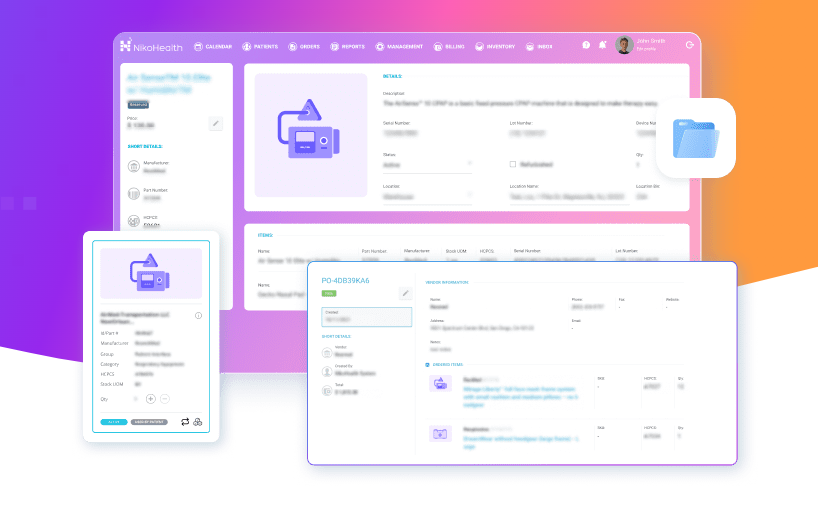In today’s fast-evolving healthcare landscape, providing high-quality patient care goes beyond hospital visits and clinical consultations. For many patients, especially those with chronic conditions or mobility limitations, Home Medical Equipment (HME) and Durable Medical Equipment (DME) play a critical role in supporting recovery, independence, and long-term well-being. Managing this equipment, however, has historically been challenging due to manual processes, fragmented communication, and compliance requirements.
This is where HME DME software comes into play. By streamlining the ordering, delivery, tracking, billing, and maintenance of medical equipment, this technology helps providers not only improve operational efficiency but also enhance the overall patient experience.
This article explores in detail how HME DME software improves patient care, boosts satisfaction, and ensures a more reliable and personalized healthcare journey.
Understanding the Role of HME and DME in Patient Care
Before diving into the benefits of software, it’s important to understand the role of HME and DME in healthcare:
- HME (Home Medical Equipment) refers to devices and tools designed for use in a patient’s home, such as hospital beds, oxygen concentrators, nebulizers, wheelchairs, and blood pressure monitors.
- DME (Durable Medical Equipment) includes medically necessary, reusable devices prescribed by healthcare professionals to manage long-term health conditions. Examples include CPAP machines for sleep apnea, walkers, infusion pumps, and ventilators.
These tools are vital for improving patient outcomes, enabling independence, and reducing hospital readmissions. However, without efficient tracking, timely delivery, and accurate billing, patients often face delays, frustrations, or even risks to their health.
How HME DME Software Enhances Patient Care
1. Faster Access to Equipment
One of the biggest challenges patients face is the delay in receiving prescribed equipment. Traditional manual processes involve paperwork, phone calls, and approvals, which can take days or even weeks.
HME DME software digitizes these workflows. Physicians can send prescriptions electronically, providers can check inventory instantly, and equipment can be dispatched quickly. This reduces waiting times and ensures patients get what they need without unnecessary delays.
Impact on patient care: Timely access to oxygen therapy, mobility aids, or respiratory devices can prevent complications and significantly improve recovery outcomes.
2. Improved Accuracy in Orders and Documentation
Errors in prescriptions or equipment fulfillment can have serious consequences for patients. A wrong size wheelchair or incorrectly set oxygen concentrator not only frustrates patients but also endangers their health.
HME DME software minimizes such errors by automating data entry, verifying prescriptions, and integrating with electronic health records (EHR). It ensures that the right equipment, in the right size and configuration, is provided to the right patient.
Impact on patient care: Accurate order fulfillment prevents miscommunication, increases patient confidence, and eliminates unnecessary risks.
3. Enhanced Patient Communication and Support
Patients often feel overwhelmed managing their conditions at home, especially when using complex medical devices. Without clear instructions, they may misuse equipment, leading to poor health outcomes.
With HME DME software, providers can send automated reminders, instructional videos, and setup guides directly to patients. Integrated patient portals also allow patients to track orders, request support, and communicate with providers seamlessly.
Impact on patient care: Better communication fosters trust, empowers patients to take charge of their health, and reduces anxiety about managing equipment at home.
4. Streamlined Insurance and Billing Processes
Billing for HME and DME is notoriously complex, requiring prior authorizations, insurance verification, and compliance with payer requirements. Delays in these processes often leave patients waiting for essential equipment.
HME DME software automates billing workflows, checks insurance eligibility in real time, and ensures compliance with regulations. This minimizes denied claims and accelerates approvals.
Impact on patient care: Patients experience less financial stress and gain quicker access to necessary equipment without bureaucratic roadblocks.
5. Proactive Maintenance and Equipment Tracking
Faulty or poorly maintained equipment can compromise patient safety. For example, a malfunctioning ventilator can be life-threatening.
With integrated medical equipment management software, providers can track the status of each device, schedule preventive maintenance, and monitor usage remotely. Some advanced solutions even integrate IoT sensors to alert providers about potential equipment failures.
Impact on patient care: Patients enjoy peace of mind knowing their equipment is reliable, safe, and regularly serviced.
6. Personalized Care and Data Insights
Every patient’s needs are unique, and personalization is key to improving outcomes. HME DME software collects and analyzes data on equipment usage, patient feedback, and clinical results. Providers can then tailor recommendations, adjust prescriptions, or suggest alternative solutions.
For example, if a patient struggles to comply with CPAP therapy, the system can flag it to the provider, who can offer guidance or recommend alternative options.
Impact on patient care: Personalized care leads to higher satisfaction, better adherence to treatment, and improved health outcomes.
7. Enhanced Compliance and Safety
Healthcare providers must adhere to strict compliance standards when delivering medical equipment. Non-compliance can lead to patient harm, legal issues, and penalties.
HME DME software ensures that all documentation, prescriptions, and billing records meet compliance standards such as HIPAA and CMS regulations. It also keeps audit trails, making inspections smoother and more transparent.
Impact on patient care: Patients benefit from safe, compliant services that protect their privacy and well-being.
Patient Experience Improvements Beyond Clinical Outcomes
Improving patient care is not only about medical outcomes but also about the overall experience. Here’s how HME DME software enhances patient satisfaction:
- Convenience: Patients can order, track, and manage equipment online without endless phone calls.
- Transparency: Real-time updates keep patients informed about delivery times and insurance approvals.
- Empowerment: Educational resources help patients use equipment correctly, boosting independence.
- Trust: Reliable processes build stronger relationships between patients and providers.
When patients feel supported and valued, they are more likely to stay engaged in their treatment and recommend providers to others.
The Role of Technology in the Future of Patient Care
The integration of HME DME software is just the beginning. With advancements in artificial intelligence, machine learning, and IoT, the future holds even more possibilities:
- Remote monitoring: Providers can track how patients use their equipment in real time.
- Predictive analytics: AI can predict equipment needs based on patient history and prevent shortages.
- Smart devices: IoT-enabled medical equipment can alert providers before malfunctions occur.
- Telehealth integration: Seamless connection with virtual care platforms will allow physicians to prescribe and monitor HME/DME instantly.
These innovations will transform patient care into a more proactive, personalized, and technology-driven experience.
Final Thoughts
The shift to patient-centered healthcare requires providers to go beyond traditional models of care. HME DME software bridges the gap between clinical treatment and home-based support, ensuring patients receive timely, accurate, and safe medical equipment.
By streamlining processes, improving communication, and enhancing personalization, this technology significantly improves both patient care and the overall healthcare experience. Combined with medical equipment management software, it also ensures reliability, compliance, and long-term safety.
In essence, investing in HME DME software is not just about improving operations—it’s about putting patients first. And in today’s healthcare environment, patient-centered innovation is the key to better outcomes and lasting trust.

